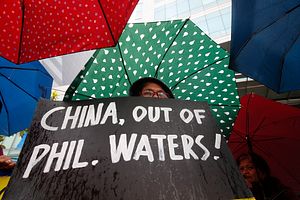The Philippine government protested last week that the presence of large numbers of Chinese vessels near islands and islets occupied by the Philippines in the disputed South China Sea was illegal and vowed to take “appropriate action.”
The Department of Foreign Affairs issued the rare public rebuke of the Chinese presence after the Philippine military monitored more than 200 Chinese vessels from January to March in a disputed area named Sandy Cay near a Philippine-occupied island called Pag-asa by Filipinos.
“The presence of Chinese vessels near and around Pag-asa and other maritime features … is illegal,” the department said in a statement. “Such actions are a clear violation of Philippine sovereignty, sovereign rights, and jurisdiction as defined under international law.”
The department said it has lodged diplomatic protests and raised concerns in meetings with Chinese officials, and that the presence of Chinese military, fishing or other vessels in the area would “continue to be the subject of appropriate action by the Philippines.”
The Philippines regards the Spratly chain of islands and islets, nine of which it occupies, in a contested region in the South China Sea as a municipality it calls Kalayaan under its western province of Palawan. That claim conflicts with the larger territorial claims of China, Vietnam, and three other governments in a long-simmering Asian dispute.
A 2002 accord between China and the 10-nation Association of Southeast Asian Nations aims to prevent armed confrontation in the busy waterway, where much of Asia’s oil and trade transits.
“We call on concerned parties to desist from any action and activity that contravenes the ASEAN-China Declaration on the Conduct of Parties in the South China Sea as these generate tension, mistrust, and uncertainty, and threaten regional peace and stability,” the Philippine statement said.
Chinese boats have swarmed around Sandy Cay, a chain of three sandbars that naturally emerged in recent years, since 2017. The sandbars lie between Pag-asa, which is internationally called Thitu, and a Chinese man-made island called Subi.
The Philippines tried to occupy the largest sandbar, about 2.5 nautical miles (4.6 kilometers) from Thitu, in 2017 but China strongly protested. Shortly after, Chinese navy, coast guard, and fishing vessels converged at the sandbars, and the Philippines halted planned construction and withdrew on the orders of President Rodrigo Duterte, Defense Secretary Delfin Lorenzana said at the time.
The Philippines delivered a protest note to the Chinese Embassy in Manila on March 29. Philippine officials again raised strong concern over the Chinese vessels near Sandy Cay and Thitu, along with two other Philippine-occupied islets, in a meeting with Chinese counterparts on Wednesday in Manila, a Philippine official said.
In Beijing, Chinese foreign ministry spokesperson Geng Shuang said Chinese and Philippine officials on Wednesday discussed problems in the South China Sea constructively in the latest in a series of meetings that began in 2017.
“The two sides discussed the ways to handle problems with a cooperative attitude and reiterated that they will continue cooperation and discuss measures to promote trust,” he said when asked about the Philippines’ concern.
Duterte has taken a nonconfrontational approach to the territorial disputes with China as he seeks trade, investment, and infrastructure funding. That apparently has not led to Beijing soft-pedaling its territorial dispute with the Philippines.
Duterte has so far refused to take up with China a ruling by an international tribunal that invalidated Beijing’s sprawling claims in the South China Sea, sparking criticism from nationalist and left-wing groups, which wanted him to demand immediate Chinese compliance with the landmark decision. China did not participate in the international arbitration and has defied its ruling.
Duterte and Chinese President Xi Jinping agreed in a statement last November to exercise self-restraint to prevent an escalation of the territorial disputes.
“We call on the Chinese government to adhere to this consensus reached at the highest levels, down to its agencies and its military,” the Philippine foreign affairs department said.
By Jim Gomez for The Associated Press. Associated Press writer Christopher Bodeen in Beijing contributed to this report.

































